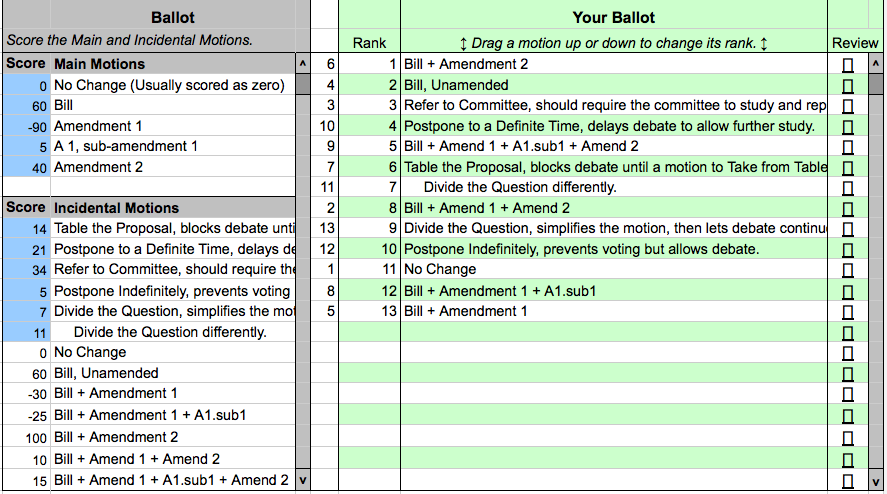|
Different uses for voting
need different types of voting. |
 |
Policy Ballots |
 |

Merits of Preference BallotsMore Choices, More Control, Better Decisions Faster Yes-no ballots promote false dichotomies and social polarization. Preference ballots, on the other hand, let council members rank many versions of a bill. This cuts sequence effects, and tricks such as freeloader and poison-pill amendments. All these merits reduce some sources of controversy and hostility within a council. In old rules of order amendment A is decided first, then voters do not have a chance to vote on both amendment B with A and on amendment B without A. One of those combinations is dead even though it could be the most popular. Because all combinations are not tallied, the outcome is erratic. And partly because it is erratic, it is easier to manipulate. Imagine two trees: The old tree has leaves on only 1 of its 2 large limbs, and only 1 of that limb's 2 branches has leaves and only 1 of that branch's 2 twigs has leaves. 1/2 × 1/2 × 1/2 = 1/8 choice. The new tree has leaves on all of its limbs, branches and twigs. 2/2 × 2/2 × 2/2 = 1 whole choice. That illustrates the difference between old and new rules of order.
Each preference ballot holds all “final” motions. These include the original proposal and all its amendments, plus motions to postpone, to table, and so forth. Often, some amendments are mutually exclusive. The chairperson, parliamentarian or rules committee may judge some combinations incompatible before the vote is taken. Their decision may be appealed to a majority override. An issue with few amendments can be decided by a show of hands, as detailed below. An issue with more than a handful of amendments is handled more quickly by entering ballots into a computer tally sheet. The introduction to preference ballots showed examples of machine-readable and manual-entry forms. The interactive ballots shown next can help voters wrestling with many many amendments.
Ballot Assistant SoftwareThe interactive ballot has two steps: First the rep scores each distinct motion. The computer uses her scores to rank the large list of compatible combinations. Then the rep adjusts these ranks for the Condorcet tally. Ballot step 1: Please score each proposal.
The ballot assistant program then estimates the scores for all
*Note: A1.s1 could be incompatible with A2 even if A1 is compatible. The ballot assistant uses those scores to create a ranked list.
Ballot step 2:
Motions to Delay The number of combinations increases faster than the number of amendments and having to rank many items is a burden for reps, reducing the time they have to consider each proposal. The burden can be controlled by limiting the number of amendments, perhaps by requiring a number of sponsors. The ballot assistant makes it easy to trade votes. Two reps can agree, "I'll score your amendment the same as mine if you will do the same." More Choices, More Control, Better Decisions Faster A Powerful Ballot Made EasyFor voters to have power, they need ballots that make it easy to rank many options.
Instructions for the Ranked-Choice Ballot
|

You can play with this prototype as an Excel spreadsheet or a Google spreadsheet. © 2012
|
Conducting a Condorcet Vote by Show of HandsDebate the issue and proposals.Print and hand out the ballots. While people vote, draw a table with a column and a row for each option. (See for example Table II.) Ask "Raise your hand if you ranked A above B" Count the hands and write the number in the B row of column A. Ask "Raise your hand if you ranked B above A" Count the hands and write the number in the A row of column B. If B, wins ask "Raise your hand if you ranked B above C". Continue comparing the previous winner with the next option. Ask for a show of hands to fill each cell in the winner's column. It must get a majority in every cell of its column or else there is a voting cycle. If a voting cycle occurs, use a completion rule to pick one of the options in the top cycle, (LOR calls for using IRV.) vote again, continue debate, table the issue or postpone it to a time certain. Later, you could verify the tally by entering the ballots on a computer program. But some (shy) voters might not have raised their hands every time their ballots called for it. (Several can be downloaded free from the tools page.) Next: full-choice ballots and software to help voters rank combinations of amendments. |

|
|



 Accurate Democracy
Accurate Democracy 








